Zurich, Switzerland - August 12, 2012 - Aiming to use electron spins for storing, transporting and processing information, researchers from IBM (NYSE:IBM) and scientists at ETH Zurich, a leading European university, today revealed the first-ever direct mapping of the formation of a persistent spin helix in a semiconductor.
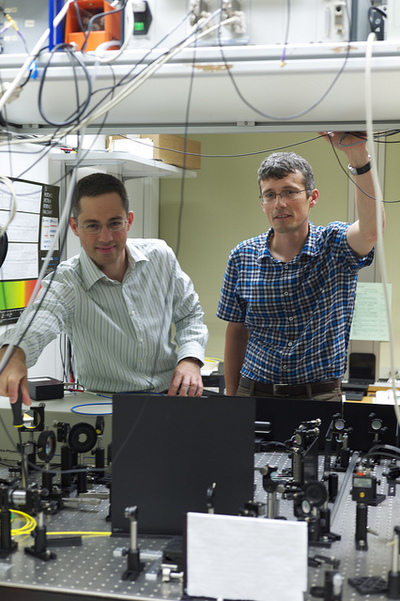 |
IBM scientists Matthias Walser (left) and Gian Salis who published the finding with C. Reichl and W. Wegscheider from ETH Zurich in the 12 August 2012 online edition of Nature Physics.
Courtesy of IBM |
| |
Zurich, Switzerland - August 12, 2012
- IBM Research is the first to synchronize electron spins and image the formation of a persistent spin helix.
- Spintronics could enable a new class of magnetic-based semiconductor transistors resulting in more energy efficient electronic devices.
Aiming to use electron spins for storing, transporting and processing information, researchers from IBM (NYSE:IBM) and scientists at ETH Zurich, a leading European university, today revealed the first-ever direct mapping of the formation of a persistent spin helix in a semiconductor.
Until now, it was unclear whether or not electron spins possessed the capability to preserve the encoded information long enough before rotating.
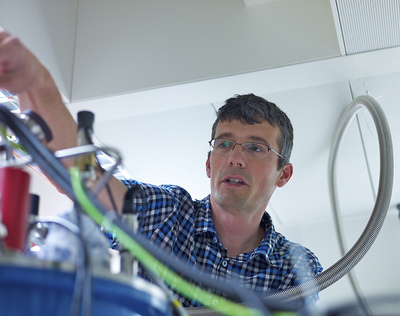 |
IBM scientists Gian Salis who published the finding with his colleague Matthias Walser and C. Reichl and W. Wegscheider from ETH Zurich in the 12 August 2012 online edition of Nature Physics.
Courtesy of IBM |
| |
Unveiled in the peer-reviewed journal Nature Physics, scientists from IBM Research and the Solid State Physics Laboratory at ETH Zurich demonstrated that synchronizing electrons extends the spin lifetime of the electron by 30 times to 1.1 nanoseconds - the same time it takes for an existing 1 GHz processor to cycle.
Today's computing technology encodes and processes data by the electrical charge of electrons.
However, this technique is limited as the semiconductor dimensions continue to shrink to the point where the flow of electrons can no longer be controlled.
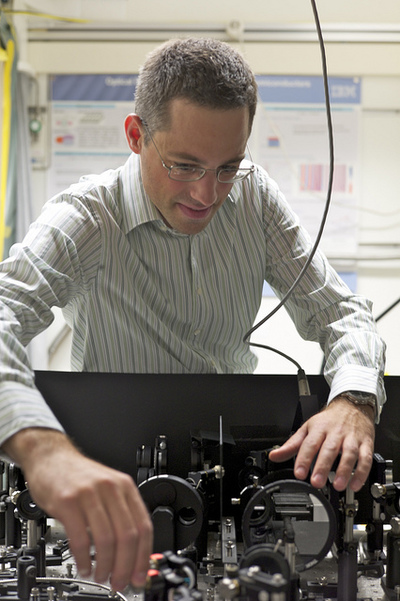 |
IBM scientists Matthias Walser who published the finding with his colleague Gian Salis and C. Reichl and W. Wegscheider from ETH Zurich in the 12 August 2012 online edition of Nature Physics.
Courtesy of IBM |
| |
Spintronics could surmount this approaching impasse by harnessing the spin of electrons instead of their charge.
This new understanding in spintronics not only gives scientists unprecedented control over the magnetic movements inside devices but also opens new possibilities for creating more energy efficient electronics.
The Spintronics Waltz
A previously unknown aspect of physics, the scientists observed how electron spins move tens of micrometers in a semiconductor with their orientations synchronously rotating along the path similar to a couple dancing the waltz, the famous Viennese ballroom dance where couples rotate.
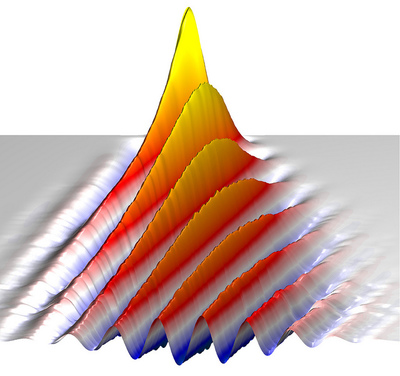 |
Spinhelix rendering.
Courtesy of IBM Research – Zurich |
| |
Dr. Gian Salis of the Physics of Nanoscale Systems research group at IBM Research – Zurich explains,
"If all couples start with the women facing north, after a while the rotating pairs are oriented in different directions. We can now lock the rotation speed of the dancers to the direction they move. This results in a perfect choreography where all the women in a certain area face the same direction. This control and ability to manipulate and observe the spin is an important step in the development of spin-based transistors that are electrically programmable."
How it Works
IBM scientists used ultra short laser pulses to monitor the evolution of thousands of electron spins that were created simultaneously in a very small spot.
Atypically, where such spins would randomly rotate and quickly loose their orientation, for the first time, the scientists could observe how these spins arrange neatly into a regular stripe-like pattern, the so-called persistent spin helix.
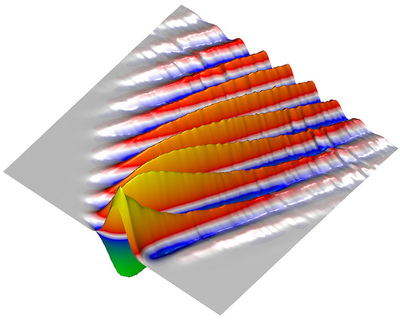 |
Spinhelix rendering.
Courtesy of IBM Research – Zurich |
| |
The concept of locking the spin rotation was originally proposed in theory back in 2003 and since that time some experiments have even found indications of such locking, but until now it had never been directly observed.
IBM scientists imaged the synchronous 'waltz' of the electron spins by using a time-resolved scanning microscope technique.
The synchronization of the electron spin rotation made it possible to observe the spins travel for more than 10 micrometers or one-hundredth of a millimeter, increasing the possibility to use the spin for processing logical operations, both fast and energy-efficiently.
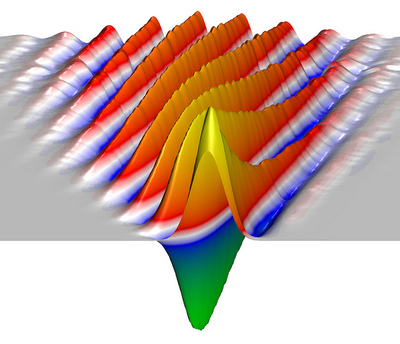 |
Spinhelix rendering.
Courtesy of IBM Research – Zurich |
| |
The reason for the synchronous spin motion is a carefully engineered spin-orbit interaction, a physical mechanism that couples the spin with the motion of the electron.
The semiconductor material called gallium arsenide (GaAs) was produced by scientists at ETH Zurich who are known as world-experts in growing ultra-clean and atomically precise semiconductor structures.
GaAs is a III/V semiconductor commonly used in the manufacture of devices such as integrated circuits, infrared light-emitting diodes and highly efficient solar cells.
 |
Spinhelix rendering.
Courtesy of IBM Research – Zurich |
| |
Transferring spin electronics from the laboratory to the market still remains a major challenge.
Spintronics research takes place at very low temperatures at which electron spins interact minimally with the environment. In the case of this particular research IBM scientists worked at 40 Kelvin (-233 C, -387 F).
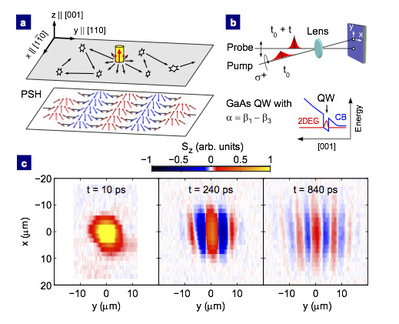 |
FIG. 1: Direct mapping of the persistent spin helix formation.
a, Diffusive expansion of a local spin excitation (top), where the spin polarization evolves into a PSH mode (bottom). The arrows and the colors indicate the direction of S and the magnitude of Sz respectively.
b, Schematic of time-resolved Kerr rotation microscopy (see methods) and profile of conduction-band energy of the 12-nm-wide GaAs/AlGaAs QW sample investigated.
c, Experimental observation of the PSH. Spatial maps of Sz(x,y) are shown for three different times t.
Courtesy of Nature Physics / IBM Research – Zurich |
| |
This work was financially supported by the Swiss National Science Foundation through National Center of Competence in Research (NCCR) Nanoscale Sciences and NCCR Quantum Science and Technology.
 |
FIG. 2: Helical spin modes and the PSH.
a, The spins of the two helical spin modes ω+ and ω− rotate with opposite helicity as the electron moves along y. The Sz(y) of the two modes is the same.
b, Spins precess about an external magnetic field Bx such that the ω+ mode is shifted towards −y if Bx < 0 is applied.
c, d, Maps of Sz(y,t) show the time evolution of the PSH for Bx = 0 (c) and Bx = −1T (d). Sz(y) oscillates in both cases, but for Bx = −1T, the position of constant phase, y0, is shifted with t (marked by the dashed line).
Courtesy of Nature Physics / IBM Research – Zurich |
| |
The scientific paper entitled "Direct mapping of the formation of a persistent spin helix" by M.P. Walser, C. Reichl, W. Wegscheider and G. Salis was published online in Nature Physics, DOI 10.1038/NPHYS2383 (12 August 2012).
Contacts information
Michael Loughran
IBM Media Relations, Research
1 (914) 945-1613
mloughra@us.ibm.com
ETH Zurich
Media Relations
+41 44 632 41 41
media_relations@hk.ethz.ch
Christopher P. Sciacca
IBM Media Relations, Research (Europe)
+41 44 72 48 443
cia@zurich.ibm.com
Source: IBM
http://www-03.ibm.com/press/us/en/pressrelease/38566.wss
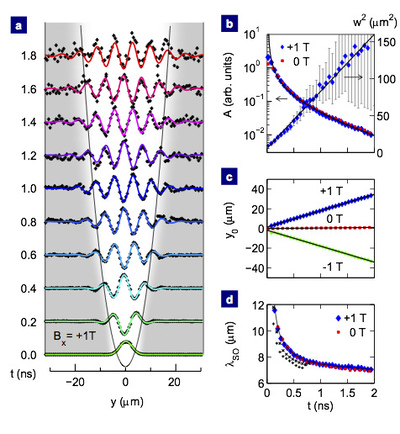 |
FIG. 3: Spin diffusion and SOI characterization.
a, Normalized line scans Sz(y) for various t. The experimental data (symbols) are fit to A exp(−y2/4w2) × cos 2π(y − y0)/λSO (solid lines). The parabola follows ±2√Dst.
b, Symbols: Amplitude A and squared width w2 of the Gaussian envelope. Solid lines: fits to (t − t0)−1 exp(−t/τs) and Dst, respectively. Error bars: Uncertainty of w2 in a single fit.
c, Shift y0 of the spatial oscillation for −1, 0 and 1T.
d, Symbols: PSH period λSO for 0 and 1 T. Solid line: smoothed data at 1 T. (+) and (×): fits to data at three- and nine-fold lower pump intensities.
Courtesy of Nature Physics / IBM Research – Zurich |
| |
ASTROMAN Magazine - 2012.07.22
Spintronika: Powstał nowy typ tranzystora, owoc polskiej technologii
http://www.astroman.com.pl/index.php?mod=magazine&a=read&id=1281
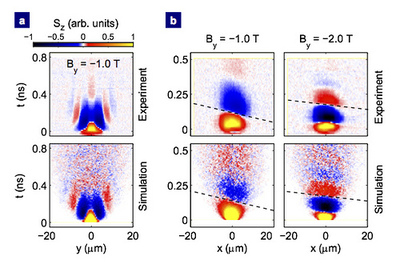 |
FIG. 5: Interplay of the PSH with an external magnetic field.
a, Experimentally measured and numerically simulated maps of Sz(y,t) for By = −1T. The formation of a helical spin mode is challenged by simultaneous spin precession about By.
b, Maps of Sz(x,t) recorded at By = −1 and −2 T show the spin precession about By as well as an asymmetry of the precession phase with ±x (dashed lines), which is attributed to a slight detuning from the SU(2) symmetry point.
Courtesy of Nature Physics / IBM Research – Zurich |
| |
ASTROMAN Magazine - 2012.07.05
CERN experiments observe particle consistent with long-sought Higgs boson
http://www.astroman.com.pl/index.php?mod=magazine&a=read&id=1266
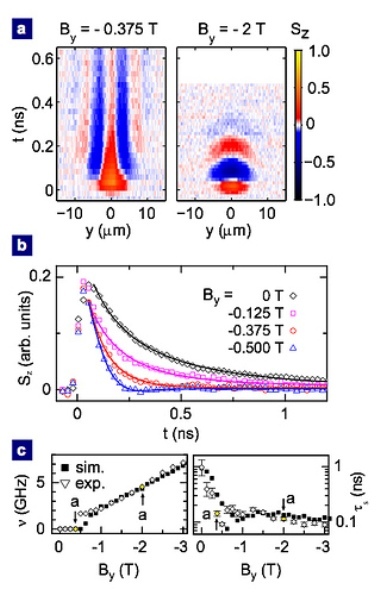 |
FIG 6: Detuning from the PSH regime.
a, Left: Maps of Sz(y,t) for By = −0.375T. The PSH is still visible, but the spin lifetime has decreased to a few 100ps. Right: Maps of Sz(y,t) for By = −2 T. Instead of the formation of a PSH, a spin precession about By is seen.
b, Time traces Sz(t) exhibit no spin precession for |By| ≤ 0.375mT, and τs decreases rapidly with |By|.
c, Precession frequency ν and spin lifetime τs versus By. Open symbols: Experimental data. Filled symbols: Numerical simulation.
Courtesy of Nature Physics / IBM Research – Zurich |
| |
ASTROMAN Magazine - 2012.07.26
IBM to Power New Generation Radio Telescope and Help Probe the Origins of the Universe
http://www.astroman.com.pl/index.php?mod=magazine&a=read&id=1283
ASTROMAN Magazine - 2012.07.14
IBM Collaborates with Russian Innovation Giants to Boost Microelectronics Industry
http://www.astroman.com.pl/index.php?mod=magazine&a=read&id=1271
ASTROMAN Magazine – 2012.06.02
IBM Completes Acquisition of Vivisimo
http://www.astroman.com.pl/index.php?mod=magazine&a=read&id=1246
ASTROMAN Magazine – 2012.05.02
New IBM Business Integration Software Helps Enterprises Accelerate Adoption of Social Business, Cloud and Mobile Technologies
http://www.astroman.com.pl/index.php?mod=magazine&a=read&id=1231
ASTROMAN Magazine – 2012.04.01
IBM Increases Presence in Poland with New Branch Offices
http://www.astroman.com.pl/index.php?mod=magazine&a=read&id=1213
ASTROMAN Magazine – 2012.03.10
Made in IBM Labs: Holey Optochip First to Transfer One Trillion Bits of Information per Second Using the Power of Light
http://www.astroman.com.pl/index.php?mod=magazine&a=read&id=1197
ASTROMAN Magazine – 2012.03.03
IBM Forms Watson Healthcare Advisory Board
http://www.astroman.com.pl/index.php?mod=magazine&a=read&id=1191
ASTROMAN Magazine – 2012.01.06
European Commission Awards IBM for Energy Efficient 27 IBM Data Centers
http://www.astroman.com.pl/index.php?mod=magazine&a=read&id=1144
ASTROMAN Magazine – 2011.12.03
IBM to Produce Micron's Hybrid Memory Cube in Debut of First Commercial, 3D Chip-Making Capability
http://www.astroman.com.pl/index.php?mod=magazine&a=read&id=1111
ASTROMAN Magazine – 2011.11.11
City of Rio de Janeiro and IBM Collaborate to Advance Emergency Response System
http://www.astroman.com.pl/index.php?mod=magazine&a=read&id=1098
ASTROMAN Magazine – 2011.11.01
IBM Watson Heads to Harvard, MIT to Explore Future of Technology in Business
http://www.astroman.com.pl/index.php?mod=magazine&a=read&id=1092
ASTROMAN Magazine – 2011.10.15
IBM Joins European Consortium to Build a Smart Grid Using Renewable Energy
http://www.astroman.com.pl/index.php?mod=magazine&a=read&id=1078
ASTROMAN Magazine – 2011.10.01
Japan's KEK Research Turns to IBM to Develop Powerful Central Computer System
http://www.astroman.com.pl/index.php?mod=magazine&a=read&id=1066
ASTROMAN Magazine – 2011.09.12
WellPoint and IBM Announce Agreement to Put Watson to Work in Health Care
http://www.astroman.com.pl/index.php?mod=magazine&a=read&id=1056
ASTROMAN Magazine – 2011.09.11
IBM Broadens Efforts to Prepare Small and Medium Businesses for Growth
http://www.astroman.com.pl/index.php?mod=magazine&a=read&id=1055
ASTROMAN Magazine – 2011.09.08
3M and IBM to Develop New Types of Adhesives to Create 3D Semiconductors
http://www.astroman.com.pl/index.php?mod=magazine&a=read&id=1053
ASTROMAN Magazine – 2011.08.21
IBM Unveils Cognitive Computing Chips
http://www.astroman.com.pl/index.php?mod=magazine&a=read&id=1042
ASTROMAN Magazine – 2011.08.13
IBM Raises Bar, Records Highest Ever TPC-C Benchmark for x86 Servers
http://www.astroman.com.pl/index.php?mod=magazine&a=read&id=1031
ASTROMAN magazine
|

